
Kobellite is a gray, fibrous, metallic mineral with the chemical formula Pb22Cu4(Bi,Sb)30S69. It is also a sulfide mineral consisting of antimony, bismuth, and lead. It is a member of the izoklakeite – berryite series with silver and iron substituting in the copper site and a varying ratio of bismuth, antimony, and lead. It crystallizes with monoclinic pyramidal crystals. The mineral can be found in ores and deposits of Hvena, Sweden; Ouray, Colorado; and Wake County, North Carolina, US. The mineral was named after Wolfgang Franz von Kobell (1803–1882), a German mineralogist.

The mineral or gemstone chrysoberyl is an aluminate of beryllium with the formula BeAl2O4. The name chrysoberyl is derived from the Greek words χρυσός chrysos and βήρυλλος beryllos, meaning "a gold-white spar". Despite the similarity of their names, chrysoberyl and beryl are two completely different gemstones, although they both contain beryllium. Chrysoberyl is the third-hardest frequently encountered natural gemstone and lies at 8.5 on the Mohs scale of mineral hardness, between corundum (9) and topaz (8).
A period 5 element is one of the chemical elements in the fifth row of the periodic table of the chemical elements. The periodic table is laid out in rows to illustrate recurring (periodic) trends in the chemical behaviour of the elements as their atomic number increases: a new row is begun when chemical behaviour begins to repeat, meaning that elements with similar behaviour fall into the same vertical columns. The fifth period contains 18 elements, beginning with rubidium and ending with xenon. As a rule, period 5 elements fill their 5s shells first, then their 4d, and 5p shells, in that order; however, there are exceptions, such as rhodium.
A period 6 element is one of the chemical elements in the sixth row (or period) of the periodic table of the chemical elements, including the lanthanides. The periodic table is laid out in rows to illustrate recurring (periodic) trends in the chemical behaviour of the elements as their atomic number increases: a new row is begun when chemical behaviour begins to repeat, meaning that elements with similar behaviour fall into the same vertical columns. The sixth period contains 32 elements, tied for the most with period 7, beginning with caesium and ending with radon. Lead is currently the last stable element; all subsequent elements are radioactive. For bismuth, however, its only primordial isotope, 209Bi, has a half-life of more than 1019 years, over a billion times longer than the current age of the universe. As a rule, period 6 elements fill their 6s shells first, then their 4f, 5d, and 6p shells, in that order; however, there are exceptions, such as gold.

Cassiterite is a tin oxide mineral, SnO2. It is generally opaque, but it is translucent in thin crystals. Its luster and multiple crystal faces produce a desirable gem. Cassiterite was the chief tin ore throughout ancient history and remains the most important source of tin today.
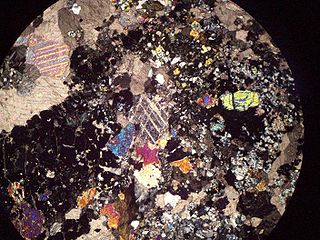
Skarns or tactites are coarse-grained metamorphic rocks that form by replacement of carbonate-bearing rocks during regional or contact metamorphism and metasomatism. Skarns may form by metamorphic recrystallization of impure carbonate protoliths, bimetasomatic reaction of different lithologies, and infiltration metasomatism by magmatic-hydrothermal fluids. Skarns tend to be rich in calcium-magnesium-iron-manganese-aluminium silicate minerals, which are also referred to as calc-silicate minerals. These minerals form as a result of alteration which occurs when hydrothermal fluids interact with a protolith of either igneous or sedimentary origin. In many cases, skarns are associated with the intrusion of a granitic pluton found in and around faults or shear zones that commonly intrude into a carbonate layer composed of either dolomite or limestone. Skarns can form by regional or contact metamorphism and therefore form in relatively high temperature environments. The hydrothermal fluids associated with the metasomatic processes can originate from a variety of sources; magmatic, metamorphic, meteoric, marine, or even a mix of these. The resulting skarn may consist of a variety of different minerals which are highly dependent on both the original composition of the hydrothermal fluid and the original composition of the protolith.
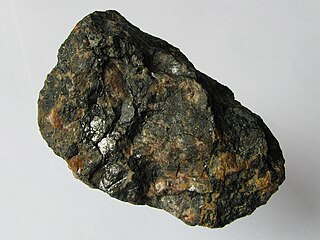
Coffinite is a uranium-bearing silicate mineral with formula: U(SiO4)1−x(OH)4x.

Samarskite is a radioactive rare earth mineral series which includes samarskite-(Y), with the chemical formula (YFe3+Fe2+U,Th,Ca)2(Nb,Ta)2O8 and samarskite-(Yb), with the chemical formula (YbFe3+)2(Nb,Ta)2O8. The formula for samarskite-(Y) is also given as (Y,Fe3+,U)(Nb,Ta)O4.

Bismuthinite is a mineral consisting of bismuth sulfide (Bi2S3). It is an important ore for bismuth. The crystals are steel-grey to off-white with a metallic luster. It is soft enough to be scratched with a fingernail and rather dense.

Bismutite or bismuthite is a bismuth carbonate mineral with formula Bi2(CO3)O2 (bismuth subcarbonate). Bismutite occurs as an oxidation product of other bismuth minerals such as bismuthinite and native bismuth in hydrothermal veins and pegmatites. It crystallizes in the orthorhombic system and typically occurs as earthy to fibrous masses.

A native metal is any metal that is found pure in its metallic form in nature. Metals that can be found as native deposits singly or in alloys include aluminium, antimony, arsenic, bismuth, cadmium, chromium, cobalt, indium, iron, manganese, molybdenum, nickel, niobium, rhenium, selenium, tantalum, tellurium, tin, titanium, tungsten, vanadium, and zinc, as well as the gold group and the platinum group. Among the alloys found in native state have been brass, bronze, pewter, German silver, osmiridium, electrum, white gold, silver-mercury amalgam, and gold-mercury amalgam.

Portlandite is a hydroxide-bearing mineral typically included in the oxide mineral class. It is the naturally occurring form of calcium hydroxide (Ca(OH)2) and the calcium analogue of brucite (Mg(OH)2).
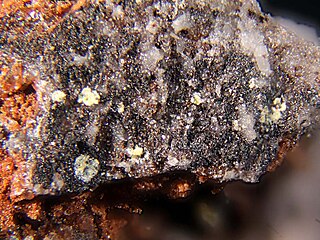
Russellite is a bismuth tungstate mineral with the chemical formula Bi2WO6. It crystallizes in the orthorhombic crystal system. Russellite is yellow or yellow-green in color, with a Mohs hardness of 3+1⁄2.

Bismuth(III) sulfide is a chemical compound of bismuth and sulfur. It occurs in nature as the mineral bismuthinite.
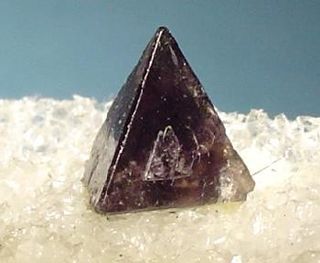
Chambersite is a manganese borate mineral with formula Mn3B7O13Cl. It is a member of the borate mineral series that includes other minerals such as ericaite and boracite. When chambersite was first discovered, it was the second chemical analogue of boracite to be found in nature. It was discovered as a mineral at Barber's Hill salt dome in Texas in 1957 and in 1971 at the Dongshuichang deposit in Jixian, Tianjin, China. Chambersite occurs associated with the evaporite minerals halite, anhydrite, and gypsum.

Studenitsite is a rare borate mineral with chemical formula of NaCa2[B9O14(OH)4]·2H2O.

Matlockite is a rare lead halide mineral, named after the town of Matlock in Derbyshire, England, where it was first discovered in a nearby mine. Matlockite gives its name to the matlockite group which consists of rare minerals of a similar structure.
Bursaite is a sulfosalt of the lillianite family. It has the formula Pb5Bi4S11 and orthorhombic structure. Bursaite is named after Bursa Province, Turkey, where it was discovered. It is generally located in regions rich in sulfur and commonly occurs alongside other sulfosalts. Its areas of formation are usually those that were once volcanogenic because it is generally aggregated with other minerals under intense heating. It was officially delisted as a mineral in 2006, being cited as an intergrowth of two other sulfosalts.

Hemusite is a very rare isometric gray mineral containing copper, molybdenum, sulfur, and tin with chemical formula Cu6SnMoS8. It was discovered by Bulgarian mineralogist Georgi Ivanov Terziev in 1963. He also described it and named it after Haemus, the ancient name of Stara planina (Balkan) mountains in Europe. The type locality is Chelopech copper ore deposit, Bulgaria. Later tiny deposits of hemusite were found in Ozernovskoe deposit, Kamchatka, Russia; Kawazu mine, Rendaiji, Shimoda city, Chūbu region, Honshu Island, Japan; Iriki mine, Iriki, Satsuma-gun, Kagoshima Prefecture, Kyushu Region, Japan; Kochbulak deposit, Tashkent, Uzbekistan. Hemusite occurs as rounded isometric grains and aggregates usually about 0.05 mm in diameter and in association with enargite, luzonite, colusite, stannoidite, renierite, tennantite, chalcopyrite, pyrite, and other minerals.
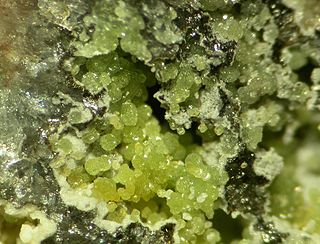
Waylandite is the phosphate analogue of arsenowaylandite and the aluminum analogue of zaïrite. The mineral was approved by the IMA in 1962, and was published the same year. Waylandite was named in honor of Edgar James Wayland. It is a member of the alunite supergroup, and a member of the plumbogummite – also known as crandallite – group. So far, only two bismuth-bearing members of the alunite supergroup are known, one of which is waylandite, alongside its ferric iron analogue zaïrite.

















